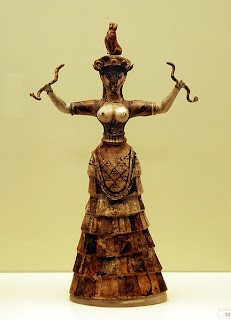Virgin & Child & Angels c. 1170
Charles Cathedral , Chartres , France
Gothic Art developed out of Romanesque art, perhaps that’s what explains the similarities in style of the Gothic period. Just like in Romanesque art, the subject matter of art continued to strongly be religious but the difference is that the church wasn’t the only patron of the arts at that time, lay people also started to pay artist to produced religious art that they could be displayed in their houses for their private veneration. Media like painting and fresco started to be more used as well as stain glass. Another significant aspect of the Gothic style, is that human figures started to look more realistic, for example, though still slender bodies were used, the artist and sculptors tried to give the human figure a bit more individuality and emotion, in fact some of the sculptures have a smile very similar to the archaic smile the early Greeks would portray on their works. Also, figures were put in a more open spaced instead of being secluded and squeezed together as many Romanesque artist did when painting figures in manuscripts or placing sculptures in niches. One of the most popular religious themes in art of the time was the portrayal of the life of virgin Mary, in fact in the picture of the stained glass above, one can see that the use of the stain glass wasn’t just coincidental but it was selected for its qualities , for when the light goes through it, it illuminates the inside of the church and makes the pictures on the stained glass more bright giving it a heavenly feeling, I'm sure that would have astonished anyone at that time. Again we can see those artists are using selective media and even their environment to create a celestial feeling in the churches, a feeling of being closer to God. It is also interesting to notice that , symbolism used by the early Christians is being used in this work of art, the dove, was used to represent the spirit of God, and is used here again as if I was giving approval to the virtuous life of the virgin Mary , also, notice the size of the Virgin Mary and Christ child compared to the size of the angels and other personages portrayed in the image, they are bigger in size and take greater space than the other figures, the use of this wasn’t exclusive to the Gothic period, in fact portraying the most important figure at a greater scale than the rest to emphasize its importance dates all the way back to the Egyptians and Assyrians.Again we can see that man is really concerned in creating places of worship worthy of not only God but of his saints and Virgin Mary .














